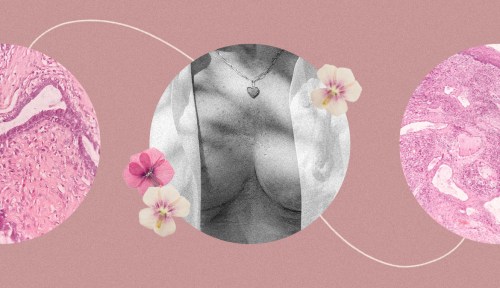Facing a Breast Biopsy? Here’s What I Wish I’d Known Before My Own Procedure
Learn exactly what to expect from a core needle biopsy of the breast from a writer who wishes she was more prepared heading into hers.

Earlier this year, I made my dutiful annual pilgrimage to have my breasts compressed between paddles like a sandwich in a panini press. Four hours later, I received a call from a nurse at the breast center who calmly told me there was a change in my left breast: two mysterious lumps. I needed to return for a second round of imaging to include another mammogram and maybe an ultrasound.
Experts in This Article
chief of breast imaging at the University of California San Francisco radiology and biomedical imaging department
lead breast imager at the City of Hope Orange County Lennar Foundation Cancer Center
nurse navigator in breast imaging for the University of California San Francisco radiology and biomedical imaging department
Being called back for another mammogram happens often and can be for a few different reasons—namely, the pictures aren’t clear enough, the breast tissue has changed since your last mammogram, or there’s a spot that looks suspicious or different from other parts of the breast, among others. While fewer than one in 10 people who are called back for a repeat mammogram have cancer, when I hung up the phone, unease and uncertainty rippled through my mind.
Fewer than one in 10 people who are called back for a repeat mammogram have cancer.
My repeat mammogram was inconclusive, and after the ultrasound, the radiologist said he suspected the two lumps were fibroadenomas, or benign breast tumors. Still, to be sure, he wanted to biopsy the larger one, or do a procedure to remove a piece of it for lab testing.
Stunned, I asked the tech, “If the doctor thinks it’s just a fibroadenoma, do we really need to do a biopsy?” With a gentle squint in her eyes, she replied, “It’s the only way to know for sure.” Before I fully processed the news, I was scheduled for a core needle biopsy (CNB) of my left breast—a procedure that caught me off guard emotionally and left me feeling unexpectedly vulnerable.
The role of a core needle breast biopsy
There are three common types of breast biopsies—fine needle aspirate (small needle), core needle (larger needle), and surgical (which involves an excision and is the most invasive). Your doctor will recommend which one they think is appropriate based on the number of lumps present, their size and location, how suspicious they appear, and your overall health, according to radiologist Jennifer Chen, MD, lead breast imager at City of Hope Orange County Lennar Foundation Cancer Center.
While, again, most breast abnormalities are non-cancerous, getting a biopsy is necessary to determine with certainty whether this is the case, “and if there is cancer, we also know that early detection is key for better outcomes,” says Dr. Chen.
As part of a core needle biopsy, the radiologist uses an ultrasound, mammogram, or magnetic resonance imaging (MRI) as a visual aid to locate the abnormal tissue or lump and guide the needle to a position where it can be used to remove a small piece of it. Your doctor will make the decision of which type of imaging technique to use based on the type of lesion present, according to radiologist Bonnie N. Joe, MD, PhD, chief of breast imaging at the University of California San Francisco (UCSF) radiology and biomedical imaging department.
In my case, I was scheduled for an ultrasound-guided core needle biopsy, which Dr. Chen says is typically a “reliable and safe diagnostic procedure recommended based on the features of the lump and the general health of the patient.”
Once the biopsy is retrieved, it’s sent to a pathology lab for testing that determines whether any cancerous cells are present.
Setting expectations for my own core needle biopsy
Leading up to my appointment, I attempted to earn my honorary online medical degree, reading as much about the core needle biopsy procedure as possible. From what I found, it seemed easy enough. Many resources like the American Cancer Society, Susan G. Komen, and others pinned it as simple, quick, painless, and non-invasive with an easy-to-understand description along these lines: A core needle biopsy uses a hollow needle to remove suspicious breast tissue for pathology to see if there are abnormalities.
Feeling skeptical about what I might not know, I sought additional insights from friends and family, hoping to hear firsthand, unfiltered experiences, but I came up empty. On the day of my procedure, I teetered between a six and an eight on the confidence scale and wound up convincing myself that I was fine to go alone, not wanting to interrupt my husband’s work day.
At the appointment, the nurse asked if someone had explained each step of the procedure to me—but when the nurse navigator had called to confirm a few days prior, I hadn’t taken the opportunity to ask for the details. I figured I had enough information from Dr. Google; I’d learned that the procedure would involve some numbing and the insertion of a needle and that it would take about 15 minutes.
But as I would find out from the nurse in the moments before my own CNB, “there’s more to it than that.” As she explained the steps (“inject a numbing solution,” “make a tiny prick,” “…this vacuum machine will make a loud sucking noise,” “…hold pressure to control any bleeding…”), I began to wish I’d brought my husband with me, so he could be waiting with a comforting hug when it was all over. I fanned myself with a brochure to stay cool, hide my quivering chin, and dry my weepy eyes.
As I lay on my back with my arm awkwardly behind my head and my breast exposed, I was grateful for the visual distraction painted on the ceiling—branches of white dogwood flowers stretched on a faux blue sky. When the doctor said, “More numbing, just a bit more numbing…” and while pushing the needle in, “So sorry…the tissue is so dense, I’m having a hard time getting to the spot,” I tried to distract my mind from what I knew was happening and imagined a cool summer breeze swaying those branches in the wind. But I was interrupted by the guck guck of the vacuum pulling my breast tissue through the long hollow needle, like a Shop-Vac sucking up Jell-O.
I found myself wishing I had asked the nurse navigator a few specific questions in advance, like, “How is the tissue extracted?” and “How big is the needle?” and “What happens after the biopsy?”
I found myself wishing I had asked the nurse navigator a few specific questions in advance, like, “How is the tissue extracted?” and “How big is the needle?” and “What happens after the biopsy?” Dr. Joe recommends all biopsy patients ask these kinds of questions when they receive the call from the nurse or nurse navigator before their appointment, “so you understand what to expect during the biopsy, any activity restrictions you may have afterward, and how you will receive the pathology results.”
What happens during an ultrasound-guided core needle biopsy of the breast
Dr. Chen explains what you can expect during a CNB, which typically lasts around 10 to 20 minutes:
- 1.A local anesthetic is injected into the breast for numbing. It may sting at first, but that feeling will quickly go away.
- 2.Once the area is numb, a hollow needle (about one inch long and the thickness of a pencil) will be inserted into the breast tissue. You’ll be awake during the biopsy, lying on your back with your arm behind your head, and you should only feel pressure or pushing. If you feel anything sharp, let the team know so they can give you more numbing medication.
- 3.An ultrasound is used to guide the placement of the needle, which is then used to remove several samples of tissue. As the tissue is removed, don’t be startled if you hear a noise like the sound of a spring-loaded stapler or a vacuum. (Your doctor will use one of these two methods to pull tissue into the needle.)
- 4.Following the biopsy, a small marker—typically a coil-shaped clip the size of an eyelash—is placed in the breast so that the doctor can closely monitor the site. You shouldn’t feel the marker in your breast. While the clip may be made of stainless steel, ceramic, or nitinol (a metal alloy of nickel and titanium), you won’t set off the security alarms at the airport.
After the biopsy is complete, the radiologist will do a post-biopsy mammogram to ensure that the marker has been placed correctly. While Dr. Joe is right when she says that “this step is usually not painful because the breast is still numb from the biopsy,” I was weary about having my now bandaged breast manipulated and squeezed between two paddles immediately after having had a needle pushed into it. I didn’t want to touch my breast myself, let alone have anyone else touch it, especially since the nurse said she would need to check my bandage after the mammogram for any “excessive bleeding.” Thankfully, I didn’t feel pain, just pressure and some heightened sensitivity. (There was a small amount of bleeding after the mammogram, but nothing abnormal.)
I feel relieved and lucky that my biopsy resulted in a benign diagnosis, as is the case for 80 percent of the more than one million breast biopsies done annually in the U.S. “Don’t assume the worst if your doctor recommends a breast biopsy,” says Dr. Chen. “Needing one doesn’t necessarily mean [you have] cancer, and this procedure is also among the essential tools for preventing and catching breast cancer early, before it has advanced.”
“[A breast biopsy] is among the essential tools for preventing and catching breast cancer early, before it has advanced.” —Jennifer Chen, MD, radiologist
Even so, Dr. Chen acknowledges that breast biopsies can be stressful for patients from the time before the procedure to the time afterward when they are waiting for results—all of which I certainly experienced. In retrospect, I believe having more details about the procedure and taking both mental and tactical steps to prepare would have helped to keep my own stress at bay and improve my experience.
Indeed, a 2020 study of more than 150 patients undergoing their first breast biopsy found that while pre-biopsy anxiety is common, most people fare better during the procedure than they anticipate, and learning about the procedure—including the positive experiences of previous patients—can provide helpful reassurance.
How to prepare for a breast biopsy in order to avoid surprises and stress
- 1.Ask your care team questions, and seek a detailed explanation of the steps of the procedure beforehand. They are there to guide you. I wish I had known to utilize them as a resource.
- 2.Bring a supportive undergarment (like a comfortable sports bra or a wireless bralette) to wear after the biopsy. The nurse will likely give you a small ice pack to place between the bandage and your bra to reduce bruising and swelling. I also wore my bralette to bed for a few nights for additional support.
- 3.Plan to take it easy for the rest of the day after your biopsy. You’ll want to avoid strenuous exercise, including weight-lifting or aerobic workouts, for one to two days afterward.
- 4.Shower before your appointment because afterward, you’ll need to wait 24 hours to bathe and four days to submerge the incision spot. You’ll have Steri-Strip bandages on the incision for five days or until they start to peel off on their own. For fun, the nurse applied mine in the shape of a star.
- 5.Expect bruising, tenderness, and swelling for a few days after the procedure; the intensity and duration can vary, but mine lasted for about five days. Rotating the ice pack on and off in 15-minute intervals for several hours helped to minimize my discomfort. I chose to ice intermittently for 24 hours.
- 6.Bring a supportive family member, friend, or spouse to the appointment. Seeing a familiar and loving face afterward may be comforting and help you relax; I found myself wishing I’d brought my husband or a supportive friend. Even though it’s not required, having someone to drive you or accompany you home may be nice, too.
While my core needle biopsy was relatively painless and not surgically invasive, I felt queasy, shaky, and tired afterward—perhaps a physical response from my body to the anxiety I felt before and during the procedure. Though not everyone will feel this way, Dr. Joe says it can certainly happen; a small 2012 study found that a “significant subpopulation” of those undergoing a breast biopsy can experience physical symptoms of distress and fatigue post-biopsy, irrespective of diagnosis.
In my perspective, the brochures and online resources don’t convey how exposed and vulnerable you may feel during and after a breast biopsy, coupled with the worry of waiting for results. If I had known that the nurse navigator could share a lot of knowledge about the procedure in advance, I would have asked detailed questions. According to Sueann Mark, PhD, MS, RN, AOCNS, lead breast imaging nurse navigator at the UCSF radiology and biomedical imaging department: “Just knowing what to expect can go a long way toward lessening the fear and anxiety of the procedure.”
Sign Up for Our Daily Newsletter
Get all the latest in wellness, trends, food, fitness, beauty, and more delivered right to your inbox.
Got it, you've been added to our email list.










